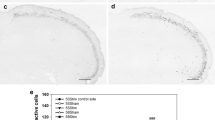Abstract
A significant reduction of the escape threshold to mechanical stimulation of the lateral facial skin was observed bilaterally at days 2 and 3 after unilateral complete Freund’s adjuvant (CFA) administration into parotid gland. A slight reduction of mechanical escape threshold was also observed in rats with saline administration. The parotid gland inflammation was verified and quantified by measuring the tissue Evans’ blue dye extravasation. The Evans’ blue concentration in the parotid gland tissues was significantly greater in the CFA-injected rats than that of the saline-injected rats at 72 h after treatment. On day 10 after CFA administration into the parotid gland, the Evans’ blue concentration was recovered to the control level. The administration of capsaicin into the parotid gland did not alter neuronal activities in the transition zone between the trigeminal spinal subnucleus interpolaris and caudalis (Vi/Vc). In contrast, capsaicin administration induced significant increases in the receptive field size and mechanical and cold responses of neurons located in superficial laminae of the C1/C2. The subgroup of C1/C2 neurons responded to mechanical distension of the parotid gland, whereas no Vi/Vc neurons responded to parotid distension.
Access this chapter
Tax calculation will be finalised at checkout
Purchases are for personal use only
Similar content being viewed by others
References
Hall H.D. and Schneyer C.A. (1973) Role of autonomic pathways in disuse atrophy of rat parotid Proc Soc Exp Biol Med 143, 19–23.
Hathaway C.B., Hu J.W. and Bereiter D.A. (1995) Distribution of Fos-like immunoreactivity in the caudal brainstem of the rat following noxious chemical stimulation of the temporomandibular joint J Comp Neurol 356, 444–56.
Imbe H., Dubner R. and Ren K. (1999) Masseteric inflammation-induced Fos protein expression in the trigeminal interpolaris/caudalis transition zone: contribution of somatosensory–vagal–adrenal integration Brain Res 845, 165–75.
Korzeniewska-Rybicka I. and Plaznik A. (2001) Role of serotonergic and noradrenergic systems in a model of visceral pain Pol J Pharmacol 53, 475–80.
Marchettini P., Simone D.A., Caputi G. and Ochoa J.L. (1996) Pain from excitation of identified muscle nociceptors in humans Brain Res 740, 109–16.
Ochoa J. and Torebjork E. (1989) Sensations evoked by intraneural microstimulation of C nociceptor fibres in human skin nerves J Physiol 415, 583–99.
Simone D.A., Marchettini P., Caputi G. and Ochoa J.L. (1994) Identification of muscle afferents subserving sensation of deep pain in humans J Neurophysiol 72, 883–9.
Sluka K.A. (2002) Stimulation of deep somatic tissue with capsaicin produces long-lasting mechanical allodynia and heat hypoalgesia that depends on early activation of the cAMP pathway J Neurosci 22, 5687–93.
Leipzig B. and Obert P. (1979) Parotid gland swelling J Fam Pract 9, 1085–93.
Orser B. (1990) Facial pain in the recovery room secondary to acute parotitis Anesthesiology 72, 1090–1.
Vasama J.P. (2000) Tympanic neurectomy and chronic parotitis Acta Otolaryngol 120, 995–8.
Watkin G.T., Hobsley M. (1986) Natural history of patients with recurrent parotitis and punctate sialectasis Br J Surg 73, 745–8.
Nozaki H., Harasawa A., Hara H., Kohno A., Shigeta A. (1994) Ultrasonographic features of recurrent parotitis in childhood Pediatr Radiol 24, 98–100.
Stanley R.B., Fernandez J.A., Peppard S.B. (1983) Cervicofacial mycobacterial infections presenting as major salivary gland disease Laryngoscope 93, 1271–5.
Ekstrom J., Asztely A. and Tobin G. (1996) Non-adrenergic, non-cholinergic influences on parotid acinar degranulation in response to stimulation of the parasympathetic innervation in the anaesthetized rat Exp Physiol 81, 935–42.
Ogawa A., Ren K., Tsuboi Y., Morimoto T., Sato T. and Iwata K. (2003) A new model of experimental parotitis in rats and its implication for trigeminal nociception Exp Brain Res 152, 307–6.
Acknowledgments
This study was supported in part by Sato and Uemura Funds from Nihon University School of Dentistry, and a grant from the Dental Research Center, Nihon University School of Dentistry; Nihon University multidisciplinary research grant for KI; grants from the Ministry of Education, Culture, Sports, Science, and Technology to promote multidisciplinary research project “Translational Research Network on Orofacial Neurological Disorders” at Nihon University School of Dentistry and “Kakenhi #18890204” to AO, and Nihon University School of Dentistry. We also thank Dr. DA Thomas for correcting English usage.
Author information
Authors and Affiliations
Corresponding author
Editor information
Editors and Affiliations
Rights and permissions
Copyright information
© 2012 Springer Science+Business Media, LLC
About this protocol
Cite this protocol
Okada-Ogawa, A., Shinoda, M., Honda, K., Iwata, K. (2012). New Models of Experimental Parotitis and Parotid Gland Distension in Rats. In: Luo, Z. (eds) Pain Research. Methods in Molecular Biology, vol 851. Humana Press. https://doi.org/10.1007/978-1-61779-561-9_9
Download citation
DOI: https://doi.org/10.1007/978-1-61779-561-9_9
Published:
Publisher Name: Humana Press
Print ISBN: 978-1-61779-560-2
Online ISBN: 978-1-61779-561-9
eBook Packages: Springer Protocols




